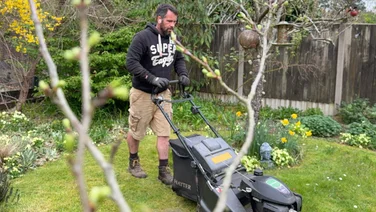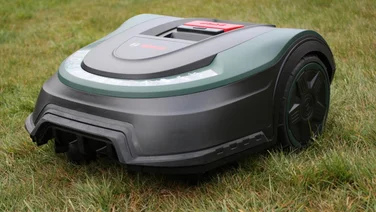To help us provide you with free impartial advice, we may earn a commission if you buy through links on our site. Learn more

Your garden is a living calendar. As winter wanes, spring bulbs shoot green notifications through the soil, reminding you that it’s time to swipe your gardening gloves from the shed. Shortly after, following its long slumber in the cold, your lawn awakes. The temperatures rise, the sun shines and the soil softens; grass roots take their first thirsty drink of the year. It’s time to roll out the lawn mower and begin your routine of regular grass care for the growing season.
The question is how much you value a perfect, plump, densely populated lawn. If you value it highly – and I suspect you do, if you’re reading this – it’s essential to start cutting at the right time and ease into a regular rhythm of cuts. Get it right, and your lawn will grow lush and thick, and those pesky pockmarks of weeds will be more readily banished from your green space. And no, that doesn’t mean you have to cut your whole lawn: you can still consider doing your bit for wildlife by turning over a portion of your lawn to Plantlife’s No Mow May.
After many years of wondering where I’ve gone wrong with lawn care – my own lawn is a perennially patchy, mossy mess – I’ve spoken to a lawn expert, Paul Hicks at Stihl UK, who has shared his top tips for keeping your lawn in tip-top shape.
When should you start cutting your lawn?
- UK: Between mid-March and mid-April
If you’re reading this in March or April and staring reluctantly at a frizzy lawn and a garden shed with a UK postcode, then I may be the bearer of bad news: it doesn’t matter whether you’re speaking to a bona-fide expert or your enthusiastic local neighbourhood gardener, the best time to mow your lawn may be right now.
Paul’s advice is for gardeners to be vigilant once spring comes around, “As the weather gets warmer, the soil will be reaching ideal mowing temperatures. Your grass will be growing strongly, so you can now regularly mow your lawn; I would recommend twice a week during this peak growth period.”
You can’t, however, put a definitive date in the calendar as the perfect time to dust off the mower. It very much depends on where you are in the UK, or the world for that matter, as it’s entirely dependent on the current weather conditions. The catalyst is when the soil temperatures get warm enough to stir your lawn back into action, and the magic figure is around 6℃. Paul advocates an attentive approach, “Timing is key in order to promote growth and maintain healthy, lush grass throughout the year. A milder winter might mean the lawn needs mowing earlier in the year, but mid-March to mid-April is generally the best time to give the lawn its first cut of the season.”
How often should you mow your lawn?
- Spring – Once/twice a week (depending on growth)
- Summer – Weekly or fortnightly
- Autumn – Weekly
- Winter – Occasionally in milder weather
Broadly speaking, you want to be mowing up to twice a week at the beginning and end of the growing season and tapering down to a weekly or fortnightly chop in the summer months. It’s all about matching the speed of the growth with the cadence of your cuts, so that you’re never cutting it too harshly, or letting it grow too long.
Paul’s advice is simple, “On average, during the spring months when it’s growing quickly, I would recommend cutting your grass twice a week to keep it looking tidy and to encourage strong, healthy growth, dropping this to once a week during the summer months when growth slows.”
What time of day is best for mowing the lawn?
- Mid-morning is ideal, as long as it’s dry
If you’re already fretting about fitting in all this quality time with your lawn mower, then it very much depends on the weather. The ideal time of day is mid-morning as this gives the grass time to recover from the cut. Ideally, you don’t want to cut your lawn last thing in the early evening if there’s a risk of the temperature plummeting overnight.
Another priority is that the grass is dry – and definitely not frosty – as you can potentially damage the grass if you’re not careful. If you’re keen to get a cut in but you awake to a crisp, silvery lawn, then the RHS recommend waiting until your lawn has dried or fully defrosted.
If you’re ever in doubt that your lawn is dry enough, then it’s best to err on the side of caution and wait until the sun has had time to warm the ground and dry any remaining moisture.
How short should you cut your lawn?
- Never remove more than a third of the grass’ length
- Use regular cuts to keep it between 3cm and 5cm long
If you’re facing the first cut after the winter and you’ve left it a bit too long, then don’t rush out and rashly chop it back in one go.
Paul’s advice is to take a patient, methodical approach. “An extreme cut can do more harm than good, so make sure you cut no more than a third of the length off with each cut to avoid damaging the lawn. If your lawn is particularly long after winter, you may need to reduce the length in stages to keep your grass healthy.”
And while it might be tempting to attempt to replicate the millimetre perfect trim of your local golf green, it’s a bad idea. Paul advises that the kind of grasses normally found in residential gardens thrive with a Goldilocks approach: not too long, not too short, just right. “It’s important to make sure that the grass doesn’t grow too long – I’d recommend aiming to keep it between 3-5cm. Too long and your lawn will look untidy – too short, and it can weaken the grass and make it more prone to drying out in hot weather.”
Is there an alternative to mowing the lawn?
- Split your garden into long grass, mid-length meadow and mowed lawn
Yes, of course. There are always alternative approaches to managing a beautifully big patch of grass. If you’ve got a particularly large garden, or simply struggle to tackle a regular mow throughout summer – which, let’s be honest, is a time when many of us would rather be doing other things – then one option is to embrace Plantlife’s No Mow May or Let It Bloom June.
The Plantlife charity’s wildlife-friendly initiative encourages lawn lovers to put away the lawn mower and let wildflowers grow. It doesn’t have to take over your whole garden: if you find a certain corner of your garden is awkward to mow, then it’s the perfect opportunity to transform it into a miniature wildlife reserve and create a haven for wildflowers, long grass, clover and knapweed. Keep the area clear of grass cuttings, chemicals and fertilisers and you can let the wildflowers multiply and do your bit for bees, butterflies and moths – and you can save yourself a bunch of hard work while you’re at it.
It doesn’t mean that you shouldn’t cut the grass at all. In fact, you can maintain different sections of your lawn in different ways to provide a diverse, wildlife-friendly habitat, splitting your garden into areas of uncut long grass, occasionally trimmed mid-length meadow, and mower-managed lawn.






